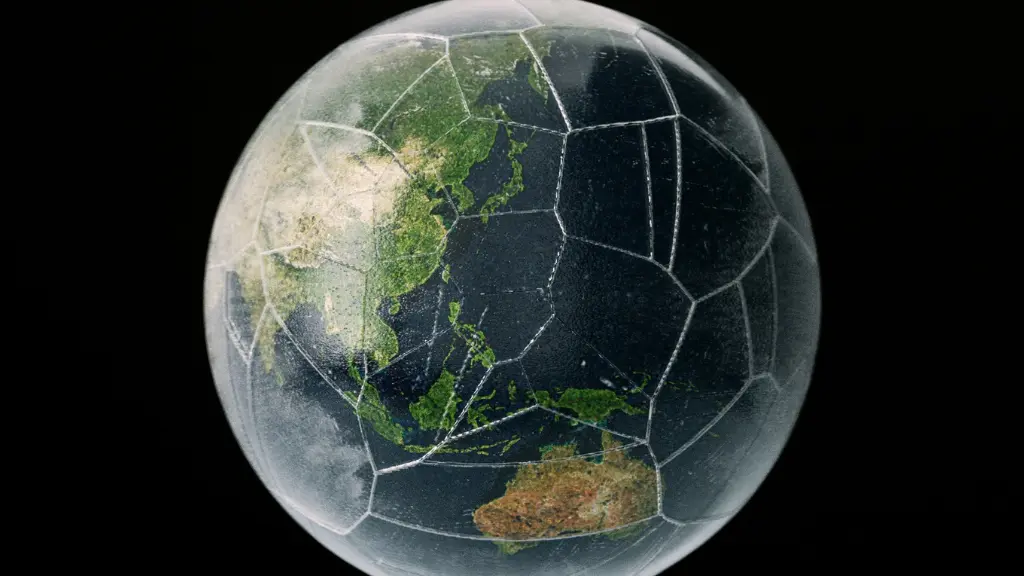

Ядро Земли — это увлекательная и загадочная часть нашей планеты. Как самый центр ядро земли, он играет решающую роль в общей структуре и поведении планеты. Ядро состоит из двух отдельных частей: внутреннего ядра и внешнего ядра.
Внутреннее ядро представляет собой твердую сферу, состоящую из железа и никеля, диаметром около 1200 километров. Оно окружено внешним ядром, которое представляет собой слой расплавленного металла толщиной около 2300 километров. Вместе эти два слоя составляют около 15% от общего объема Земли. Ядро также невероятно горячее, с температурой, достигающей до 6000 градусов Цельсия в центре.
Ученые изучают ядро Земли уже несколько десятилетий, но многое еще остается неизвестным. Однако недавние достижения в области технологий позволили исследователям лучше понять этот загадочный регион. В этой статье я более подробно рассмотрю ядро Земли, включая его состав, поведение и роль, которую оно играет в формировании нашей планеты.

Ядро Земли — центральная часть нашей планеты, расположенная под мантией и корой. Оно разделено на два слоя: твердое внутреннее ядро и жидкое внешнее ядро. Состав ядра Земли представляет большой интерес для ученых, поскольку помогает нам понять формирование и эволюцию нашей планеты.
Химический состав ядра Земли, как полагают, в основном состоит из железа (Fe) и никеля (Ni). Эти элементы составляют более 80% массы ядра, с меньшим количеством других элементов, таких как сера (S), кислород (O) и кремний (Si). Точный состав ядра трудно определить, поскольку его невозможно наблюдать напрямую. Однако ученые смогли сделать выводы о составе ядра на основе сейсмических данных и экспериментов.
Считается, что твердое внутреннее ядро Земли состоит в основном из железа с меньшим количеством никеля и других элементов. По оценкам, его радиус составляет около 1220 километров, а температура около 5000 градусов по Цельсию. Несмотря на высокую температуру, внутреннее ядро остается твердым из-за огромного давления, под которым оно находится.
Жидкое внешнее ядро земного ядра также в основном состоит из железа и никеля, но также содержит более легкие элементы, такие как сера и кислород. По оценкам, его толщина составляет около 2300 километров, а температура — около 4000 градусов по Цельсию. Магнитное поле Земли, которое защищает нас от опасного солнечного излучения, создается внешним ядром.
В заключение состав ядро земли в основном состоит из железа и никеля с меньшим количеством других элементов. Твердое внутреннее ядро и жидкое внешнее ядро играют важную роль в геологии Земли и магнитном поле ядра Земли. Для полного понимания состава и поведения ядра Земли необходимы дальнейшие исследования.

Как геофизика, меня всегда восхищала динамика земного ядра. Ядро представляет собой сложную систему, состоящую из двух отдельных слоев: внутреннего ядра и внешнего ядра. В этом разделе я исследую движения и теплообмен внутри ядра.
Ядро Земли постоянно находится в движении. Магнитное поле ядра Земли, которое защищает нас от опасного солнечного излучения, создается внешним ядром. Движение внешнего ядра обусловлено теплом, выделяемым внутренним ядром, и охлаждением внешнего ядра наверху. Это движение известно как конвекция.
Вращение Земли также играет ключевую роль в движении ядра. Эффект Кориолиса заставляет конвекционные потоки вращаться по часовой стрелке в Северном полушарии и против часовой стрелки в Южном полушарии. Это вращение создает эффект динамо, который генерирует магнитное поле Земли.
Внутреннее ядро, с другой стороны, вращается независимо от внешнего ядра. Вращение внутреннего ядра немного быстрее вращения поверхности Земли, совершая полный оборот каждые 24 часа. Это вращение генерирует небольшое количество энергии, которая, как полагают, отвечает за поддержание магнитного поля ядра.
Ядро Земли наука чрезвычайно горячее, температура достигает 6000 градусов по Цельсию. Тепло генерируется в результате распада радиоактивных изотопов и остаточного тепла от формирования Земли. Затем тепло передается из внутреннего ядра во внешнее ядро посредством теплопроводности.
Охлаждение внешнего ядра наверху создает температурный градиент, который вызывает конвекционные потоки. По мере того как горячий материал поднимается, он охлаждается и опускается обратно, создавая непрерывный цикл передачи тепла.
В заключение, динамика ядра Земли представляет собой сложную систему движений и теплопередачи. Движения ядра обусловлены конвекцией и вращением Земли, в то время как тепло генерируется за счет распада радиоактивных изотопов и остаточного тепла от формирования Земли. Понимание динамики ядра имеет решающее значение для понимания магнитного поля Земли и процессов, формирующих нашу планету.

Как ученый, изучающий Землю, я нахожу изучение магнитного поля Земли увлекательным. Магнитное поле является важным аспектом нашей планеты и играет решающую роль в нашей повседневной жизни. В этом разделе я рассмотрю роль ядра Земли в создании и поддержании магнитного поля.
Магнитное поле Земли возникает из-за движения расплавленного железа внутри внешнего ядра. Внешнее ядро представляет собой слой жидкого железа, который окружает твердое внутреннее ядро. Движение расплавленного железа генерирует электрические токи, которые в свою очередь создают магнитное поле.
Магнитное поле не статично, а постоянно меняется. Магнитные полюса могут перемещаться и даже менять полярность с течением времени. Эти изменения обусловлены сложной динамикой ядра Земли и его взаимодействием с мантией и корой.
Геомагнитные инверсии — самые резкие изменения в магнитном поле Земли. Во время инверсии магнитное поле ослабевает, а магнитные полюса меняются местами. Последняя инверсия произошла около 780 000 лет назад, и ученые все еще пытаются понять механизмы, вызывающие эти инверсии.
Одна из теорий состоит в том, что развороты вызваны изменениями потока расплавленного железа во внешнем ядре. По мере изменения потока магнитное поле ослабевает и в конечном итоге меняет направление. Другая теория состоит в том, что инверсии вызваны взаимодействием между ядром и мантией.
В заключение, магнитное поле земного ядра представляет собой сложную и динамическую систему, которая создается и поддерживается движением расплавленного железа во внешнем ядре. Магнитное поле играет важнейшую роль в нашей повседневной жизни, от указания направления компасам до защиты от вредного солнечного излучения. Понимание роли ядра в магнетизме Земли является важной областью исследований для ученых, изучающих Землю.

Как ученый, изучающий Землю, я нахожу изучение ядра Земли увлекательным. Ядро Земли — это самая внутренняя часть нашей планеты, состоящая из твердого внутреннего ядра и жидкого внешнего ядра. Ядро составляет около 15% объема Земли и 32% ее массы. Несмотря на свою важность, изучение ядра Земли является сложной задачей из-за его недоступности.
Одним из основных методов, используемых для изучения ядра Земли, является анализ сейсмических волн. Сейсмические волны — это волны энергии, которые распространяются через недра Земли, и они могут предоставить ценную информацию о свойствах ядра Земли. Анализируя время распространения и амплитуды сейсмических волн, ученые могут сделать вывод о плотности, температуре и составе ядра Земли.
Другим методом, используемым для изучения ядра Земли, является вычислительное моделирование. Оно подразумевает использование компьютерных моделей для имитации поведения ядра Земли в различных условиях. Изменяя такие параметры, как температура, давление и состав, ученые могут получить представление о динамике ядра Земли и о том, как оно влияет на магнитное поле Земли.
В заключение следует отметить, что изучение ядра Земли является сложной и трудной задачей, требующей использования множества методов и методик. Благодаря анализу сейсмических волн и вычислительному моделированию ученые получают лучшее представление о ядре Земли и его роли в формировании планеты, на которой мы живем.

Как человек, изучавший ядро Земли, я могу с уверенностью сказать, что ядро — одна из самых интересных и важных частей нашей планеты. Оно расположено в самом центре Земли и состоит из двух ядер в земных слоях: внутреннего ядра и внешнего ядра.
Граница между земным ядром и мантией известна как граница ядро-мантия. Она расположена примерно на глубине 2900 километров под поверхностью Земли. Граница отмечена резким увеличением плотности и изменением поведения сейсмических волн, которые проходят через нее.
Граница ядро-мантия является очень важной областью изучения для геологов и сейсмологов. Считается, что граница играет решающую роль в движении тектонических плит и формировании вулканической активности. Также считается, что граница отвечает за генерацию магнитного поля Земли.
Взаимодействие между ядром и корой также очень важно. Тепло земного ядра приводит в движение тектонические плиты, которые, в свою очередь, формируют поверхность Земли. Ядро также играет роль в формировании гор, поскольку движение тектонических плит может привести к тому, что кора будет прогибаться и сгибаться.
Кроме того, магнитное поле земного ядра отвечает за защиту Земли от вредного воздействия солнечного ветра и космического излучения. Без этого магнитного поля жизнь на Земле была бы намного сложнее, если не невозможна.
В целом, земное ядро является важнейшей частью недр Земли. Его взаимодействие с мантией и корой ответственно за многие геологические процессы, которые формируют нашу планету. Благодаря постоянному изучению и исследованию мы можем лучше понять ядро и его роль в истории и будущем нашей планеты.

Как человек, изучавший ядро планеты Земля, я могу с уверенностью сказать, что оно оказывает значительное влияние на поверхностные явления. В этом разделе я рассмотрю два основных способа, которыми ядро влияет на поверхность Земли: вулканическую активность и тектонические движения.
Земное ядро играет решающую роль в возникновении вулканической активности. Магма, которая является расплавленной породой, находящейся под поверхностью Земли, создается путем плавления пород в мантии и коре. Это плавление вызвано высокими температурами и давлениями, которые существуют глубоко в недрах Земли, которые в конечном итоге генерируются теплом, выделяемым ядром.
Земное ядро также влияет на состав магмы. Ядро в основном состоит из железа и никеля, и считается, что эти элементы являются источником железа и никеля, которые находятся в магме. Кроме того, магнитное поле ядра может влиять на движение магмы, что в свою очередь может влиять на местоположение и интенсивность вулканических извержений.
Земное ядро также играет важную роль в тектонических движениях, которые являются движениями плит земной коры. Тепло ядра считается основным двигателем этих движений, поскольку оно вызывает конвекционные потоки в мантии. Эти потоки, в свою очередь, управляют движением плит земной коры.
Земное ядро также влияет на состав и прочность плит земной коры. Тепло, выделяемое ядром, делает породы мантии и коры более пластичными, а это значит, что они легче деформируются. Это может привести к образованию разломов и трещин в плитах земной коры, что в конечном итоге может привести к землетрясениям.
В заключение следует сказать, что ядро земного ядра оказывает значительное влияние на поверхностные явления, особенно на вулканическую активность и тектонические движения. Понимание роли ядра в этих процессах имеет решающее значение для прогнозирования и смягчения последствий стихийных бедствий, таких как извержения вулканов и землетрясения.

Как геолог, я нахожу ядро Земли увлекательным предметом. Оно не только влияет на магнитное поле планеты, но и на океаны. В этом разделе я рассмотрю связь между ядром Земли и океанами.
Ядро Земли генерирует тепло, которое передается на поверхность посредством конвекции. Это тепло приводит в движение термохалинную циркуляцию, которая отвечает за движение воды в океанах. Термохалинная циркуляция обусловлена различиями в температуре и солености, которые создают градиенты плотности в океане.
Теплая вода от экватора течет к полюсам, где остывает и опускается на дно океана. Затем эта холодная вода течет обратно к экватору, завершая циркуляцию. Этот процесс играет решающую роль в регулировании климата ядра Земли путем распределения тепла по планете.
Ядро Земли также влияет на изменение уровня моря. Гравитационное притяжение Луны и Солнца вызывает приливы, на которые могут влиять изменения в магнитном поле Земли. Магнитное поле создается движением расплавленного железа в ядре Земли, на которое могут влиять внешние факторы, такие как солнечные бури.
Изменения уровня моря также могут быть вызваны таянием ледников и ледяных шапок, на которое влияет ядро Земли. Таяние льда может вызвать изменения в распределении массы на поверхности ядра Земли, что может повлиять на вращение планеты и гравитационное поле.
В заключение, ядро Земли играет важную роль в функционировании океанов. Термохалинная циркуляция и изменения уровня моря — это всего лишь два примера сложных взаимоотношений между ядром Земли и океанами. Как геолог, я нахожу эти взаимоотношения увлекательным предметом для дальнейшего изучения.

Как исследователь в области науки о ядре Земли, я взволнован будущими возможностями для исследований и открытий. Мы все еще так многого не знаем о внутренних процессах нашей планеты, и я верю, что продолжение исследований и разведок приведет к новым открытиям и более глубокому пониманию ядра Земли.
Одной из областей особого интереса является изучение сейсмических волн. Анализируя путь прохождения сейсмических волн через ядро Земли, мы можем получить ценную информацию о составе и структуре ядра. Продолжающиеся исследования в этой области могут привести к новым открытиям о свойствах ядра и процессах, происходящих внутри него.
Еще одним многообещающим направлением будущих исследований является использование компьютерного моделирования и симуляции. Создавая подробные модели земного ядра, мы можем моделировать поведение различных материалов и проверять различные гипотезы о процессах в ядре. Этот подход уже дал некоторые впечатляющие результаты, и я считаю, что продолжение инвестиций в эту область приведет к еще большим прорывам.
Кроме того, я считаю, что еще многое предстоит узнать из прямого исследования земного ядра. Хотя это и сложная задача, появляются новые технологии и методы, которые могут сделать ее возможной. Например, разработка передовых методов бурения и материалов может позволить нам проникнуть глубже в земную кору и достичь ядра. Аналогичным образом, достижения в области робототехники и дистанционного зондирования могут позволить нам исследовать ядро без физического проникновения в него.

В целом я с оптимизмом смотрю в будущее Земное ядро наука и потенциал для новых открытий и идей. Продолжая инвестировать в исследования и исследования, мы можем углубить наше понимание нашей планеты и сил, которые ее формируют. Посмотреть больше подобных статей можно здесь: Коул Пармер Антилия: подробный обзор.